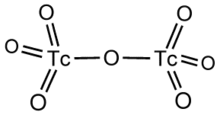| Revision as of 18:14, 10 January 2011 editM97uzivatel (talk | contribs)Extended confirmed users6,578 edits cs:Oxid technecistý← Previous edit | Revision as of 19:22, 9 March 2011 edit undoCitation bot 1 (talk | contribs)Bots130,044 editsmNo edit summaryNext edit → | ||
| Line 25: | Line 25: | ||
| }} | }} | ||
| Technetium(VII) oxide is the ] with the ] Tc<sub>2</sub>O<sub>7</sub>. This yellow volatile solid is a rare example of a molecular binary metal oxide, the other examples being RuO<sub>4</sub>, ], and the unstable ]. It adopts a centrosymmetric corner-shared bi-tetrahedral structure in which the terminal and bridging Tc-O bonds are 167pm and 184 pm respectively and the O-Tc-O angle is 180°<ref>{{cite journal| author = Krebs, B. | title = Technetium(VII)-oxid: Ein Übergangsmetalloxid mit Molekülstruktur im festen Zustand| journal = Angewandte Chemie | year = 1969 | volume = 81| pages = 328–329| doi = 10.1002/ange.19690810905}}</ref> | Technetium(VII) oxide is the ] with the ] Tc<sub>2</sub>O<sub>7</sub>. This yellow volatile solid is a rare example of a molecular binary metal oxide, the other examples being RuO<sub>4</sub>, ], and the unstable ]. It adopts a centrosymmetric corner-shared bi-tetrahedral structure in which the terminal and bridging Tc-O bonds are 167pm and 184 pm respectively and the O-Tc-O angle is 180°<ref>{{cite journal| author = Krebs, B. | title = Technetium(VII)-oxid: Ein Übergangsmetalloxid mit Molekülstruktur im festen Zustand| journal = Angewandte Chemie | year = 1969 | volume = 81| issue = 9| pages = 328–329| doi = 10.1002/ange.19690810905}}</ref> | ||
| Technetium(VII) oxide is prepared by the oxidation of ] at 450-500 °C:<ref>{{cite book| author = Herrell, A. Y.; Busey, R. H.; Gayer, K. H. | title = Technetium(VII) Oxide, in Inorganic Syntheses| year = 1977 | volume = XVII| pages = 155–158 | isbn = 0-07-044327-0}}</ref> | Technetium(VII) oxide is prepared by the oxidation of ] at 450-500 °C:<ref>{{cite book| author = Herrell, A. Y.; Busey, R. H.; Gayer, K. H. | title = Technetium(VII) Oxide, in Inorganic Syntheses| year = 1977 | volume = XVII| pages = 155–158 | isbn = 0-07-044327-0}}</ref> | ||
Revision as of 19:22, 9 March 2011

| |
| Names | |
|---|---|
| IUPAC name Technetium(VII) oxide | |
| Other names Technetium heptoxide | |
| Identifiers | |
| CompTox Dashboard (EPA) | |
| Properties | |
| Chemical formula | Tc2O7 |
| Appearance | yellow solid |
| Melting point | 119.5 °C |
| Boiling point | 310.6 °C |
| Solubility in water | hydrolysis to HTcO4 |
| Hazards | |
| Occupational safety and health (OHS/OSH): | |
| Main hazards | radioactive |
| Except where otherwise noted, data are given for materials in their standard state (at 25 °C , 100 kPa). Infobox references | |
Technetium(VII) oxide is the chemical compound with the formula Tc2O7. This yellow volatile solid is a rare example of a molecular binary metal oxide, the other examples being RuO4, OsO4, and the unstable Mn2O7. It adopts a centrosymmetric corner-shared bi-tetrahedral structure in which the terminal and bridging Tc-O bonds are 167pm and 184 pm respectively and the O-Tc-O angle is 180°
Technetium(VII) oxide is prepared by the oxidation of technetium at 450-500 °C:
- 2 Tc + 3.5 O2 → Tc2O7
It is the anhydride of pertechnic acid and the precursor to sodium pertechnetate:
- Tc2O7 + 2 NaOH → 2 NaTcO4 + H2O
References
- Krebs, B. (1969). "Technetium(VII)-oxid: Ein Übergangsmetalloxid mit Molekülstruktur im festen Zustand". Angewandte Chemie. 81 (9): 328–329. doi:10.1002/ange.19690810905.
- Herrell, A. Y.; Busey, R. H.; Gayer, K. H. (1977). Technetium(VII) Oxide, in Inorganic Syntheses. Vol. XVII. pp. 155–158. ISBN 0-07-044327-0.
{{cite book}}: CS1 maint: multiple names: authors list (link)